Figure
1: The positions in galactic coordinates of the GRBs in the BATSE 4B
catalog, showing the isotropy of the burst sky distribution (see C.A.
Meegan, et al., Nature, vol. 355, 1993, p. 143.
by Eric J. Heller
Departments of Chemistry and Physics
Harvard University, Cambridge, Massachusetts
Gamma-ray bursts pose one of the greatest mysteries of modern
astrophysics. Almost every day, there is a huge, localized burst of
gamma-rays lighting up the sky, which often outshines all the other
gamma ray sources in the sky put together. Then the source of the burst
vanishes, often in a few seconds. The bursts come from all over the sky,
seemingly at random. Until now there has been no convincing explanation
for them. The answer, it turns out, may be automotive in nature
The Mystery of Gamma Ray Bursts
Gamma ray bursts (GRB) were discovered in 1967 by satellite-borne
detectors looking for violations of the Nuclear Test Ban Treaty. They
are extremely bright sources of radiation, typically lasting for
seconds. Some are very sharply peaked in time, others have a longer
falloff. Burst time-scales go through the 30 ms scale to hundreds of
seconds. Even if the GRBs we see are somehow collimated toward us (as we
shall argue they are) , they are by far the brightest electromagnetic
events in the Universe. They are more or less randomly distributed
across the sky, as seen in Figure 1, and happen about once a day. There
is strong evidence that the GRBs seen so far are extragalactic, since
recent observations have associated faint galaxies to the burst sights.
It is now known that they emanate from distant galaxies. While the
bursts were detected in the gamma region of the spectrum, there are also
x-ray and visible portions of the spectrum. GRBs remain an active area
of research [1, 2, 3, 4, 5, 6, 7, 8, 9, 10, 11, 12, 13, 14, 15, 16, 17,
18, 19, 20]. Typical bursts are shown in Figure 2 . A galaxy from which
another burst originated is shown in Figure 3.
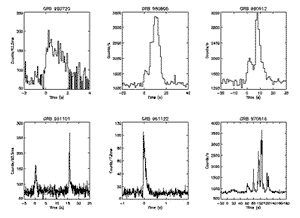
Figure
2: Sample of GRBs detected by the BeppoSAX/GRBM. It shows just an
example of the possible morphology, duration and intensity variety of
the GRBs
The explanations for these bursts have been diverse. Most involve
black holes created by massive stars. Since the collimation issue is not
resolved, the total energy in the bursts ranges enormously, depending
on the solid angle assumed for the beam. If the radiation were
isotropic, the total energy involved would be almost unimaginable and
very hard to accommodate into existing theory. On the other hand if the
bursts are extremely collimated, and we just happen to see the ones
aimed at us, the energies are more modest. None of the proposed models
is very satisfactory, in that aspects of the data remain unexplained or
that unknown physics has to be arbitrarily invoked. Here, we give a
simple explanation showing they are in fact the result of routine
activities by extraterrestrials.
Explanation
The explanation of GRBs falls into place if we consider the
activities of extraterrestrial intelligent beings. It is assumed that
such beings, in our galaxy or other galaxies, are quite capable of space
travel over great distances, at speeds near the speed of light, c. The
relativistic time dilation

, where

, dictates that travelers have a huge advantage in traveling close to
the speed of light, in terms of the space ship clock time to arrive at a
destination. The energy requirements, E, on the other hand get
arbitrarily large as the speed of light is approached, i.e.

. We are only 250 years since the invention of the steam engine;
advanced societies could easily have had a million-fold more time to
develop technology. We dare not assume they are limited in their
capacity to generate enormous amounts of energy.
Space travel at relativistic speeds is not without its hazards. It is
well known that “brown” matter and other debris populates intragalactic
space, and perhaps intergalactic space, with some density. Objects
ranging in size from baryons and atoms to masses of the order of Jupiter
might be encountered, though the larger ones would certainly be known
ahead of time, or easily seen. Smaller sized objects are another issue.
We assume here that a collision at relativistic speeds with something
the size of a baseball, or perhaps even small molecules, is bad even for
space vehicles of very advanced societies. At the very least, such
vehicles must “look ahead” for larger objects it would collide with, and
move out of the way when they are detected. It should also have a way
of moving the much more numerous small objects out of harm’s way.
In other words, space ships must have headlights, and perhaps beams
powerful enough to disintegrate or displace small bodies well in advance
of arrival. These would naturally need to be extremely collimated. The
requirement to see far enough ahead might make them quite energetic. An
observer along the line of the path vehicle would always see very blue
shifted (i.e., mostly gamma) radiation, since we would see only those
beams from ships traveling directly toward us at relativistic speeds.
But why do we see a “burst” of 0.1–10 seconds?
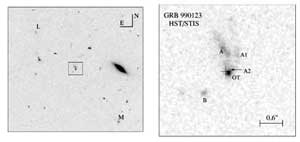
Figure
3: Galactic region (left) and host galaxy (right) from which the gamma
ray burst GRB 9901231 originated (from reference 21
If a space vehicle in another galaxy were traveling exactly in our
direction (of course at some time in the past) then perhaps we should
see their “headlights” for more than a few seconds. However, several
explanations exist for this, all of which can coexist. The burst may be
an indication that the ship has its low beams on most of the time,
switching to high beam only long enough to destroy objects in its path.
This would explain their short and variable duration (the time required
to destroy different debris is variable), and the asymmetry in time of
some GRBs, some of which have a long time tail (destruction beams from
ships may be chirped, for example, visible radiation followed by
microwave, to increase effectiveness). Secondly, depending on the
collimation, extremely slight deflections in path of the vehicle, or
deflection of the headlight beam by changes in matter distribution in
the vicinity of the vehicle would be sufficient to explain the brief
duration of the typical gamma ray “flash”. It is also possible that
small objects, once detected, are obliterated with a focused flash from
the vehicle. Thus the variation in the duration of the flashes, their
spectral content, and the total energy fluence are easily attributed to
variations in source spectral content, propagation fluctuations of the
type just mentioned, and earth’s position in the beam as it sweeps by.
Proposal for a Test
The solar system is sufficiently large to test the idea of extreme
collimation of the beam. Let us suppose that the beam has an initial
width of 100 m, with a mean wavelength of 10-12 m, in the gamma region.
Using the asymptotic formula for the spreading of a Gaussian beam (Born
and Wolf, Principles of Optics), we have the angular spread in radians,
given by radians (1)
After one billion years of travel this beam would spread to a size of
about 106 kilometers, only about 1% of the earth-sun distance. If the
GRBs are remnants of destruction beams, their width at the beam waist
might be 100 times smaller, giving a width a billion years later on the
order 1 AU. These figures make it worthwhile to contemplate building a
solar orbiting gamma ray camera, in order to detect differences between
arrival signatures on earth and on the satellite which might reveal a
beam width on the order of a few AUs or less.
Conclusion
We have shown that GRBs are explained as byproducts of narrowly
collimated headlights and protection beams of extraterrestrial vehicles
in other galaxies, where the bursts are known to originate. These beams
would have an approximately 10–15 radian spread. This explanation
requires ten to twenty orders of magnitude less energy in the source
than an assumed astrophysical “collimated” source with a beam spread of 1
to 10 degrees.
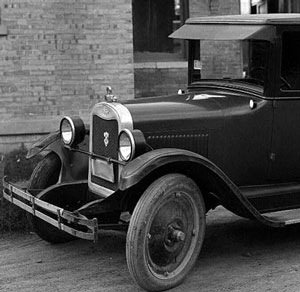
Figure 4. Headlights. This particular example is of terrestrial origin.
No one has seen a GRB originating from within our own galaxy. No
doubt there are extraterrestrials traveling around here too, but the
beams would be very narrow due to a thousand-fold or greater reduction
in propagation distance, and conceivably destructive. Probably we have
never been “hit” by one of them. Indeed, tra_c laws or common courtesy
may prohibit aiming of such concentrated radiation toward inhabited
planets in one’s own galaxy; however, other galaxies are much too
distant to have to worry about, explaining why we see bursts only from
distant galaxies.
The GRBs originate only within distant galaxies as far as we know.
This is easily explained, since extragalactic travel is either out of
the question (even for advanced societies) because of the great
distances involved, or else intergalactic space is so empty that it is
common practice to leave your headlights off when traveling between
galaxies.
Editor’s note: This work is consonant with the
evidence amassed by Scott Sandford of NASA that internal combustion
engines may be common in interstellar space. See “Proof that UFOs are
Powered by Internal Combustion Engines,” Scott A. Sandford, AIR 6:2.




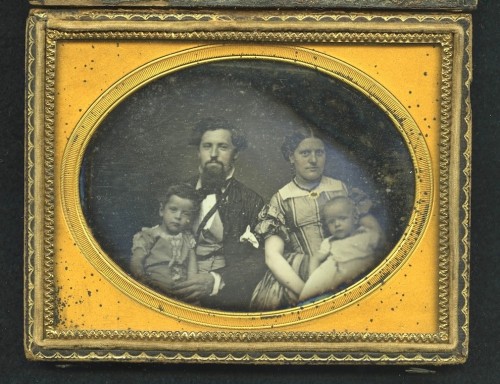
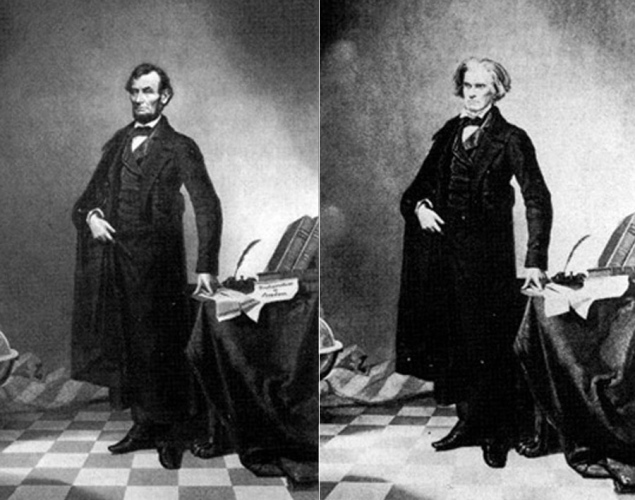





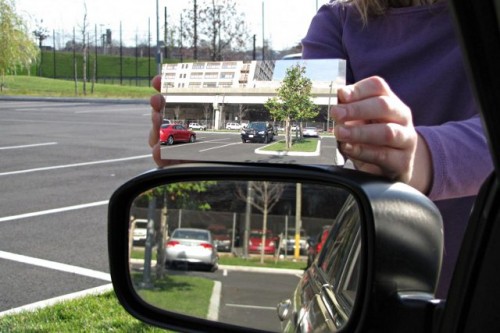
 Ooh,
the nerve of some people! Judge Lillian Sing of San Francisco released
a convicted auto thief with some stern warnings, only to get this as payback:
Ooh,
the nerve of some people! Judge Lillian Sing of San Francisco released
a convicted auto thief with some stern warnings, only to get this as payback:






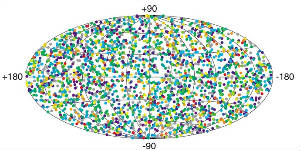





 Carnivorous
plants like the pitcher plant, Venus flytrap, and sundew have evolved
to get necessary nutrients from the bugs they eat, usually because the
soil in their environments don’t have enough of them. But a new study
shows that at least one kind of carnivorous plant, the common sundew (Drosera rotundifolia) will stop doing so when there is more nitrogen than usual in their soil, such as when nitrogen-rich acid rain falls.
Carnivorous
plants like the pitcher plant, Venus flytrap, and sundew have evolved
to get necessary nutrients from the bugs they eat, usually because the
soil in their environments don’t have enough of them. But a new study
shows that at least one kind of carnivorous plant, the common sundew (Drosera rotundifolia) will stop doing so when there is more nitrogen than usual in their soil, such as when nitrogen-rich acid rain falls.